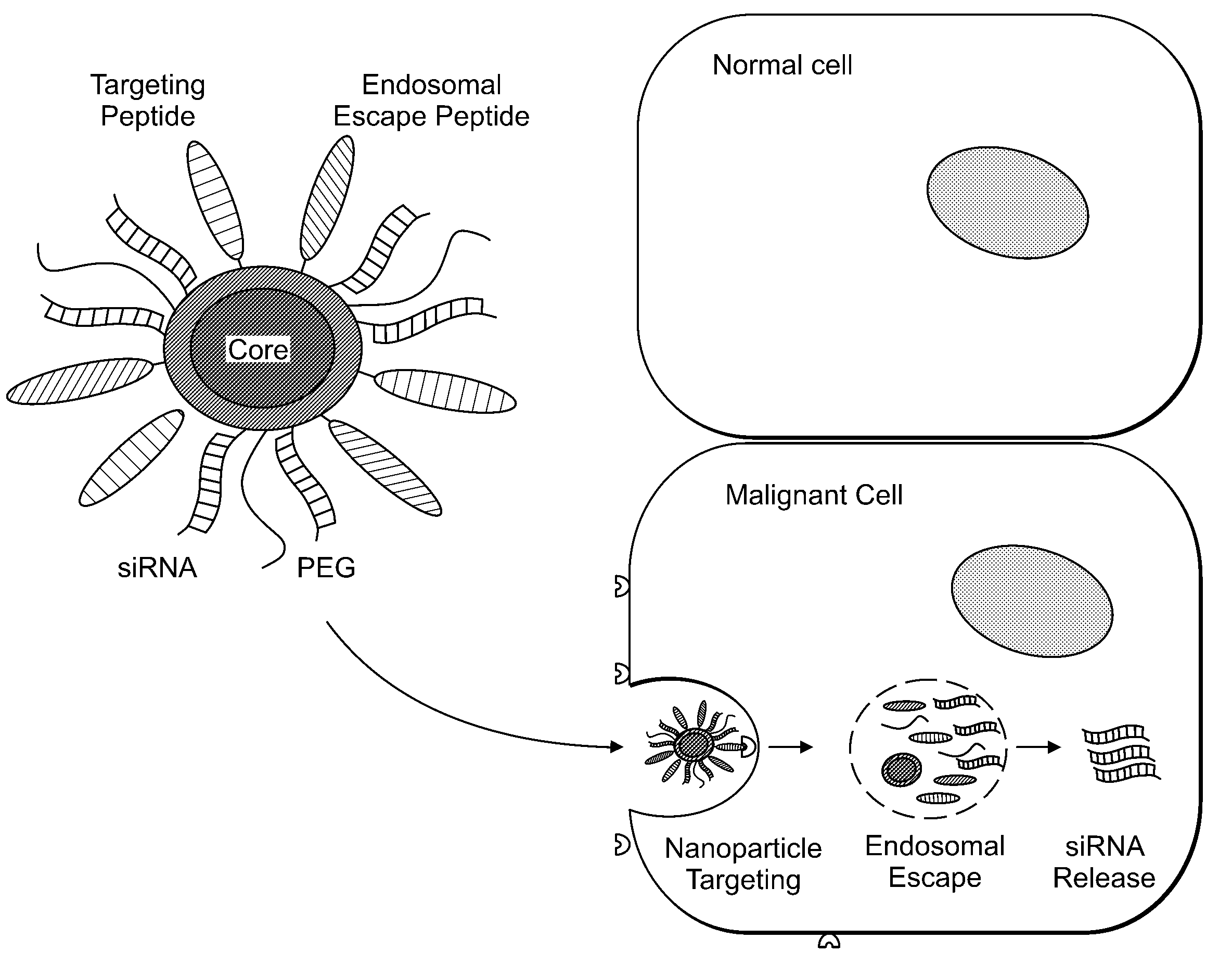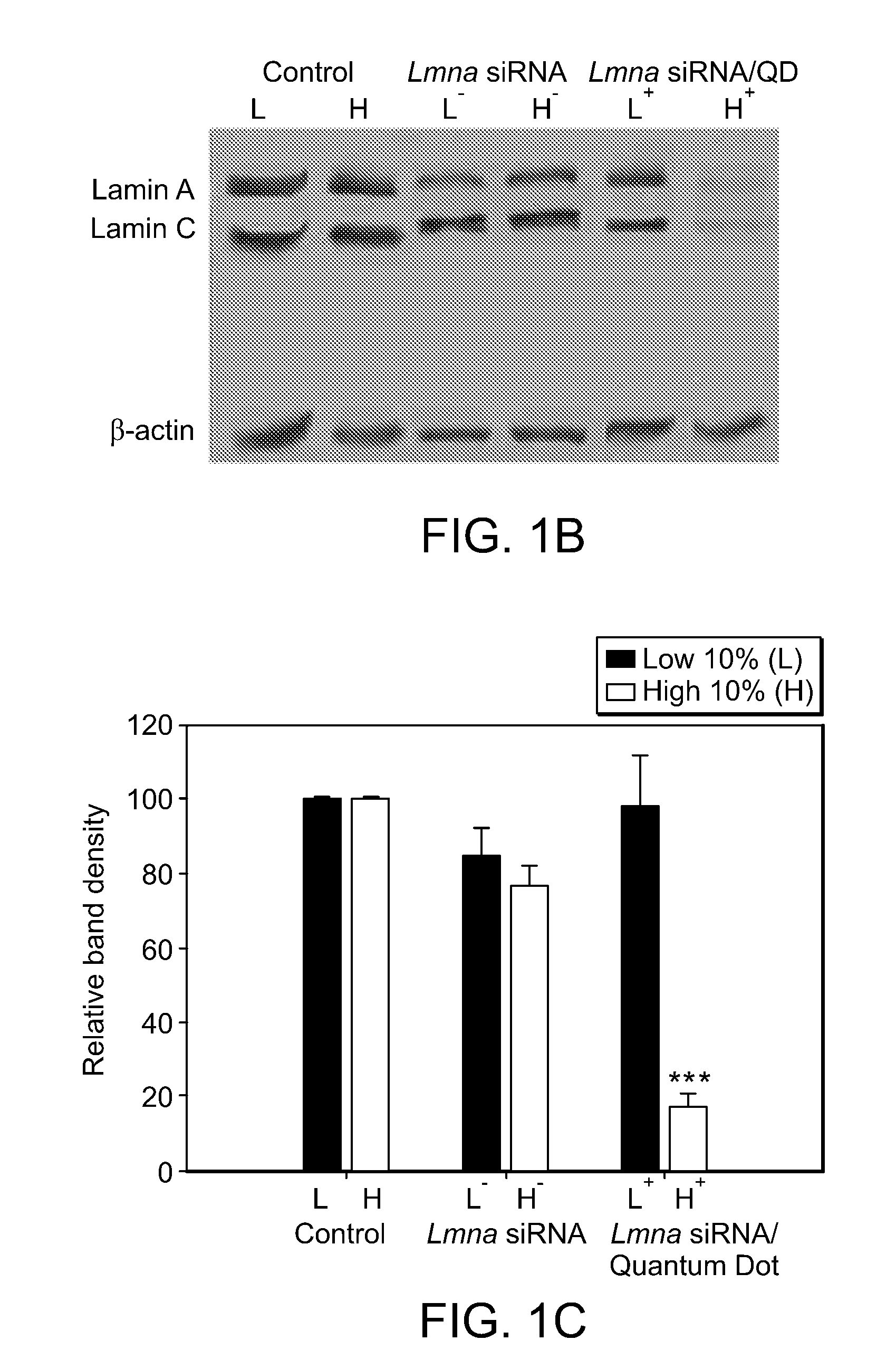Delivery of Nanoparticles and/or Agents to Cells
a nanoparticle and cell technology, applied in the field of nanoparticles and/or agents to cells, can solve the problems of variable levels of gene silencing, inability to track rnai in long-term or multiplexing, and confusion in the interpretation of genotype/phenotype correlations, so as to improve the circulation time of nanoparticles and reduce degradation of agents
- Summary
- Abstract
- Description
- Claims
- Application Information
AI Technical Summary
Benefits of technology
Problems solved by technology
Method used
Image
Examples
example 1
Co-Delivery of Quantum Dots and siRNA to Cells Allows Quantitation of siRNA Uptake and Correlation of Gene Silencing with Intracellular Fluorescence
Materials and Methods
[0357]Short Interfering RNA and Quantum Dot Preparation
[0358]Pre-designed siRNA was used to selectively silence the Lamin A / C gene (Lmna siRNA #73605, NM—019390, Ambion) and the T-cadherin gene (SMARTpool reagent CDH13, NM—019707, Dharmacon). Fluorescently-labeled Lmna siRNA purchased from Dharmacon was designed with a fluorescein molecule on the 5′ end of the sense strand. The annealed sequences were reconstituted in nuclease-free water and used at a concentration of 100 nM (Lmna siRNA, 5′-Fluorescein-Lmna siRNA) or 50 nM (T-cad siRNA).
[0359]Green (560 nm emission maxima) and orange (600 nm emission maxima) CdSe-core, ZnS-shell nanocrystals were synthesized and water-solubilized with mercaptoacetic acid (MAA) as previously described (Chan and Nie, 1998, Science, 281:2016; Hines and Guyot-Sionnest, 1996, J. Phys. Che...
example 2
Optimizing the Correlation Between QD Fluorescence and Gene Silencing
Materials and Methods
[0372]QD and siRNA synthesis, transfection, and Western blotting were performed as described in Example 1.
Results
[0373]To optimize the QD / siRNA correlative effect, we varied the ratio of QD to lipofection reagent with a fixed dose of 100 nM siRNA. Specifically, we co-complexed Lmna siRNA with QD:lipofection reagent ratios of 1:5, 1:2, 1:1 or 2:1 (corresponding to 1 μg, 2.5 μg, 5 μg, or 10 μg QD) and sorted the high 10% and low 10% of the cell fluorescence distributions as before. We found that optimal fluorescence and gene silencing correlation for the least amount of QD occurs at a 1:1 QD:lipofection reagent mass ratio (5 μg QD), as assayed by Western blot (FIGS. 3A-C). Without wishing to be bound by any theory, we hypothesize that this optimum results from the limited surface area of the cationic liposome delivery agent (approximately 1 μm2) that is shared by the siRNA and QDs during the comp...
example 3
Multiplexed Assay Allows Simultaneous Monitoring and Sorting of Cells Treated with Different siRNAs
Materials and Methods
[0374]QD and siRNA synthesis, transfection, and Western blotting were performed as described in Example 1.
Results
[0375]QDs exhibit an extensive range of size- and composition-dependent optical properties, making them highly advantageous for multiplexing (i.e. monitoring and sorting cells that have been treated simultaneously with different siRNA / QD complexes). As a demonstration of these capabilities, we complexed cationic liposomes with either green (em 560 nm) QDs and Lmna siRNA or orange (em 600 nm) QDs and siRNA targeting T-cadherin (T-cad). Cells were exposed simultaneously to both complexes and flow cytometry was used to quantify orange fluorescence (600±10 nm) versus green fluorescence (560±20 nm) (FIG. 4A). Cells exhibiting dual-color fluorescence were gated for low 8% and high 8% fluorescence and collected. Western blots probing lamin A / C and T-cad protein...
PUM
| Property | Measurement | Unit |
|---|---|---|
| pH | aaaaa | aaaaa |
| diameter | aaaaa | aaaaa |
| diameter | aaaaa | aaaaa |
Abstract
Description
Claims
Application Information
 Login to View More
Login to View More - R&D
- Intellectual Property
- Life Sciences
- Materials
- Tech Scout
- Unparalleled Data Quality
- Higher Quality Content
- 60% Fewer Hallucinations
Browse by: Latest US Patents, China's latest patents, Technical Efficacy Thesaurus, Application Domain, Technology Topic, Popular Technical Reports.
© 2025 PatSnap. All rights reserved.Legal|Privacy policy|Modern Slavery Act Transparency Statement|Sitemap|About US| Contact US: help@patsnap.com



